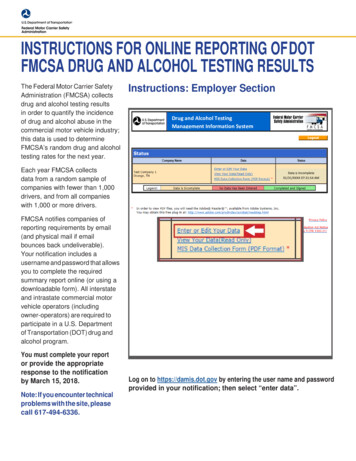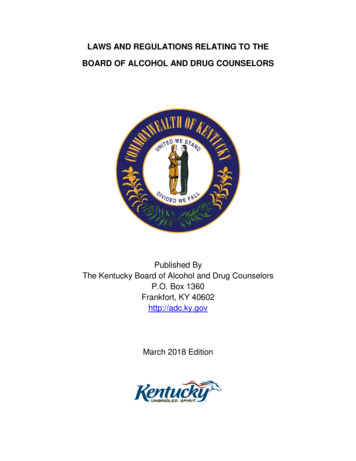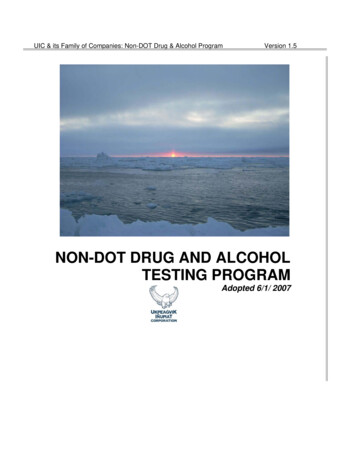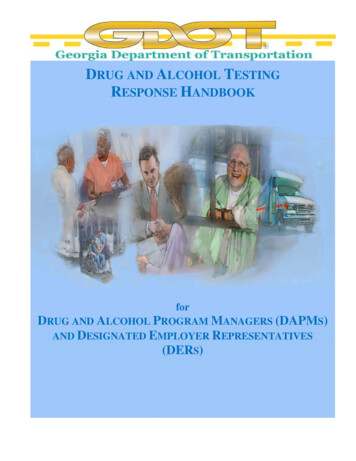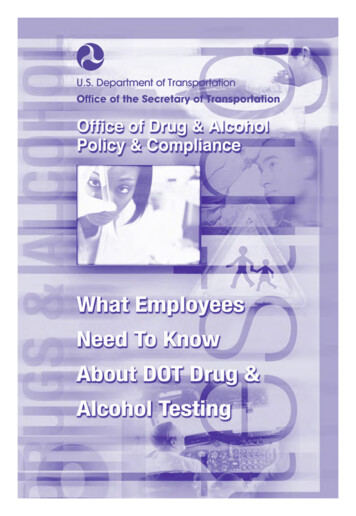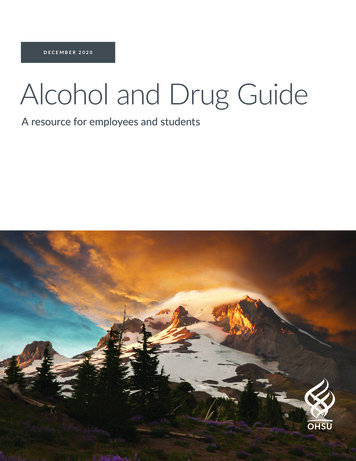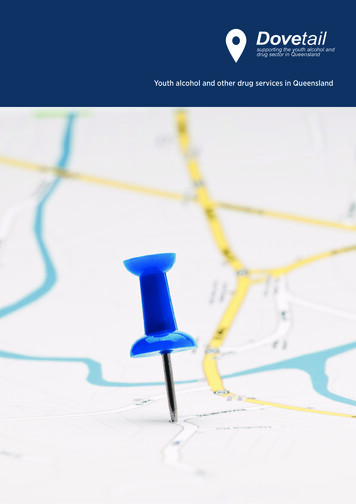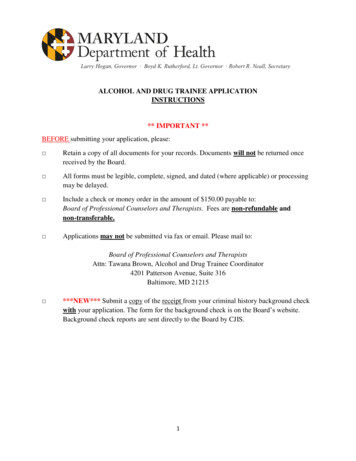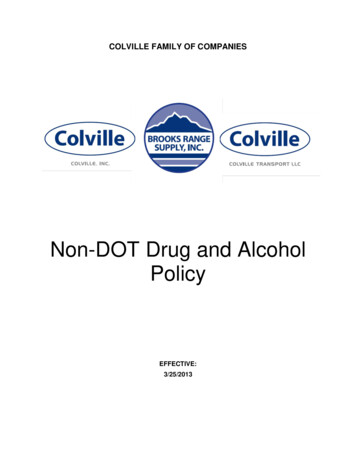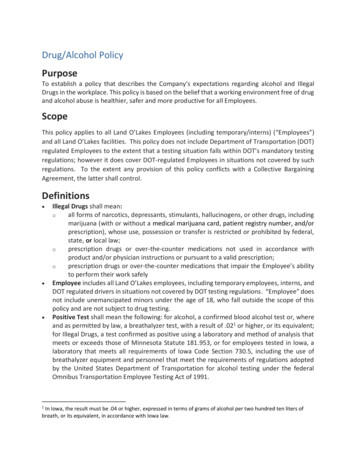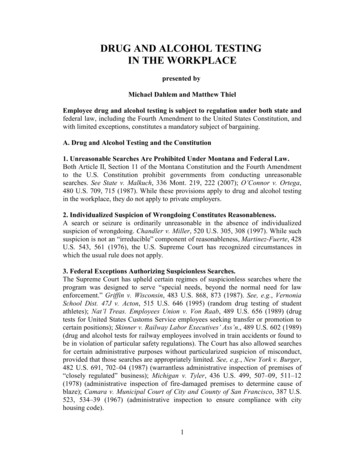
Transcription
DRUG AND ALCOHOL TESTINGIN THE WORKPLACEpresented byMichael Dahlem and Matthew ThielEmployee drug and alcohol testing is subject to regulation under both state andfederal law, including the Fourth Amendment to the United States Constitution, andwith limited exceptions, constitutes a mandatory subject of bargaining.A. Drug and Alcohol Testing and the Constitution1. Unreasonable Searches Are Prohibited Under Montana and Federal Law.Both Article II, Section 11 of the Montana Constitution and the Fourth Amendmentto the U.S. Constitution prohibit governments from conducting unreasonablesearches. See State v. Malkuch, 336 Mont. 219, 222 (2007); O’Connor v. Ortega,480 U.S. 709, 715 (1987). While these provisions apply to drug and alcohol testingin the workplace, they do not apply to private employers.2. Individualized Suspicion of Wrongdoing Constitutes Reasonableness.A search or seizure is ordinarily unreasonable in the absence of individualizedsuspicion of wrongdoing. Chandler v. Miller, 520 U.S. 305, 308 (1997). While suchsuspicion is not an “irreducible” component of reasonableness, Martinez-Fuerte, 428U.S. 543, 561 (1976), the U.S. Supreme Court has recognized circumstances inwhich the usual rule does not apply.3. Federal Exceptions Authorizing Suspicionless Searches.The Supreme Court has upheld certain regimes of suspicionless searches where theprogram was designed to serve “special needs, beyond the normal need for lawenforcement.” Griffin v. Wisconsin, 483 U.S. 868, 873 (1987). See, e.g., VernoniaSchool Dist. 47J v. Acton, 515 U.S. 646 (1995) (random drug testing of studentathletes); Nat’l Treas. Employees Union v. Von Raab, 489 U.S. 656 (1989) (drugtests for United States Customs Service employees seeking transfer or promotion tocertain positions); Skinner v. Railway Labor Executives’ Ass’n., 489 U.S. 602 (1989)(drug and alcohol tests for railway employees involved in train accidents or found tobe in violation of particular safety regulations). The Court has also allowed searchesfor certain administrative purposes without particularized suspicion of misconduct,provided that those searches are appropriately limited. See, e.g., New York v. Burger,482 U.S. 691, 702–04 (1987) (warrantless administrative inspection of premises of“closely regulated” business); Michigan v. Tyler, 436 U.S. 499, 507–09, 511–12(1978) (administrative inspection of fire-damaged premises to determine cause ofblaze); Camara v. Municipal Court of City and County of San Francisco, 387 U.S.523, 534–39 (1967) (administrative inspection to ensure compliance with cityhousing code).1
B. Drug and Alcohol Testing is a Mandatory Subject of Bargaining1. Drug Testing is a Mandatory Subject of Bargaining.Johnson-Bateman Co. and Machinists, AFL-CIO, Dist. Lodge 120, 295 NLRB 180(1989). See also General Counsel Memorandum 87-5 (September 8, 1987),Guideline Memorandum Concerning Drug or Alcohol Testing of Employees(recommending that the NLRB take the position that drug and alcohol testing be amandatory subject of bargaining). Cf. Consolidated Rail Corp. v. Railway LaborExecutives’ Ass’n., 491 U.S. 299 (1989) (Railway Labor Act).2. Testing Provisions in CBAs Must be Consistent with State and Federal Law.Where drug and alcohol testing is neither required nor prohibited by state or federallaw, testing may be negotiated by the parties to a collective bargaining agreement.Likewise, the union and the employer may bargain over testing procedures that arenot inconsistent with state or federal law.3. Testing Provisions are Permissive in CBAs Because Unions May Explicitly orImplicitly Consent to Drug and Alcohol Testing on Behalf of Employees.Bolden v. Southeastern Pennsylvania Transportation Authority and TransportWorkers Union of Philadelphia, Local 234, 935 F.2d 807 (3rd Cir. 1991); Jackson v.Liquid Carbonic Corp., 863 F.2d 111, 119 (1st Cir. 1988), cert. denied, 490 U.S.1107 (1989) (reasoning that an employee’s reasonable expectation of privacy intesting depends on the Union’s concessions during collective bargaining);Consolidated Rail Corp. v. Railway Labor Executives’ Ass’n., 491 U.S. 299, 311–12(1989) (reasoning that implied authorization of testing based on practice, usage, andcustom must be treated the same as explicit consent).C. Workplace Drug and Alcohol Testing Under Federal Law11. Safety-Sensitive Transportation Employees Must Be Tested.The Omnibus Transportation Employee Testing Act of 1991 49 U.S.C. § 5331 is afederal statute requiring drug and alcohol testing for safety-sensitive transportationemployees in aviation, trucking, railroads, mass transit, pipelines, and othertransportation industries. The Act covers a majority of the transportation workers. InFebruary 1994, the DOT expanded existing drug testing rules to include mandatorydrug testing of aviation, interstate motor carrier, railroad, pipeline, commercialmarine employees, and all employees who are required to have a commercialdriver’s license.2. The U.S. Department of Transportation (DOT) Regulates Testing.The DOT publishes rules detailing the persons who must conduct drug and alcoholtests, and the method of conducting those tests. These regulations cover alltransportation employers, safety-sensitive transportation employees, and service1Section C contains direct quotes and information from the Employer Guide to Drug Testing, MontanaDepartment of Labor and Industry website.2
agents. The Office of Drug & Alcohol Policy & Compliance (ODAPC) publishes,implements, and provides authoritative interpretations of the testing rules in Title 49Code of Federal Regulations (C.F.R.) Part 40. The Department of Transportationoversees the implementation and enforcement of this act for the public and privatesector. 49 C.F.R. §§ 391.81, 382.101, 392.1, 40.01. See Appendix A for the classesof employees covered under 49 C.F.R. Part 40.3. Procedural Regulations Apply to Federally Mandated Drug Tests.The procedural requirements are intended to protect individual privacy, ensureaccountability and integrity of specimens, require confirmation of all positivescreening tests, mandate the use of laboratories operating within certain guidelines,provide confidentiality for test results and medical histories, and ensurenondiscriminatory testing methods. The procedural regulations are enforced byadministrative remedies in the form of civil and criminal penalties. 49 U.S.C. § 521;49 C.F.R. § 382.507. There is no private cause of action available to aggrievedemployees for a violation of the procedural protections. Williams v. UPS, 527 F.3d1135 (10th Cir. 2008).6. Title 49 Requires Laboratory Testing for Five Classes of Drugs:MarijuanaCocaineOpiates – opium and codeine derivativesAmphetamines and methamphetaminesPhencyclidine – PCP49 C.F.R. Part 40 Subpart F. The DOT does not prohibit motor carrier employersfrom instituting a “company authority” testing program that is in addition to, anddistinct from, the required DOT testing program. Under such non-DOT programs,employers could test for other drugs. DOT also does not prohibit employers fromusing tests of non-urine specimens under a non-DOT program. DOT regulations at §382.601 provide that employer materials supplied to drivers may include informationon additional employer policies with respect to the use of alcohol or controlledsubstances, including any consequences for a driver found to have a specifiedalcohol or controlled substances level, that are based on the employer’s authorityindependent of this part. Any such additional policies or consequences must beclearly and obviously described as being based on the employer’s independentauthority.7. Types of DOT Drug and Alcohol Tests:a. Pre-employment – An employer must receive a negative drug test resultbefore permitting a CDL driver to operate a CMV. (§ 382.301).b. Post-accident – Drug and alcohol tests may be required after crashesaccording to the following chart (§ 382.303):3
Type of Accident InvolvedCitation IssuedHuman FatalityYesHuman FatalityNoBodily Injury with Immediate MedicalTreatment Away from the SceneYesBodily Injury with Immediate MedicalTreatment Away from the SceneNoDisabling Damage to Any Motor VehicleRequiring Tow AwayYesDisabling Damage to Any Motor VehicleRequiring Tow AwayNoTest Must Be PerformedYesYesYesNoYesNoc. Random – CDL drivers must be randomly tested throughout the year (§382.305); a self-employed driver, who is not leased to a motor carrier, shallimplement a random testing program of two or more covered employees in therandom testing selection pool as a member of a consortium (see § 382.305; FMCSAQ&A No. 11).d. Reasonable suspicion – Drivers who appear to be under the influence ofdrugs or alcohol can be immediately tested (§ 382.307). Employers must train CDLdriver supervisors to detect the symptoms of driver impairment (§ 382.603).e. Return-to-duty – Required for drivers who tested positive, refused, orotherwise violated the prohibitions of 49 C.F.R. Part 382 Subpart B; and who havecompleted the return-to-duty process with a DOT-qualified substance abuseprofessional. This test is directly observed, and a negative result is required beforeresuming driving duties (§ 382.309 and § 40.305).f. Follow-up – Required for drivers who tested positive, refused, orotherwise violated the prohibitions of 49 C.F.R. Part 382 Subpart B; and who havecompleted the return-to-duty process with a DOT-qualified substance abuseprofessional, and have tested negative for a return-to-duty test. This testing isprescribed by the substance abuse professional for a minimum of 6 directly observedtests in 12 months but can be extended an additional four years (§ 382.311 and §40.307).8. 49 C.F.R. § 40 Does Not Address Disciplinary Actions After a Positive Test.However, it instructs employers to (1) immediately remove the employee fromperforming DOT safety-sensitive jobs and (2) provide the employee with a list ofqualified Substance Abuse Professionals (SAPs). An employer must ensure that theemployee (1) received an SAP evaluation and (2) successfully complied with theSAP’s evaluation recommendations before allowing an employee to return to asafety-sensitive position following a positive test.4
D. Workplace Drug and Alcohol Testing Under Montana Law21. Montana Law Does Not Mandate Drug and Alcohol Testing.The Montana Workforce Drug and Alcohol Testing Act (the “Act”), Mont. CodeAnn. §§ 39–2–205 through 39–2–211, a copy of which is provided as Appendix B,does not mandate the drug or alcohol testing of any employee in Montana. Nor doesit contain provisions for its enforcement by any state or local government agency orgrant any agency rule making, interpretive, or other regulatory authority. Remediesfor violations of the Act are available only by way of a private, civil cause of action,brought in an appropriate court.2. All Employers Opting to Test Employees Must Adhere to Title 49.While the Act does not mandate drug and alcohol testing, it does require allemployers using drug and alcohol testing to adopt procedures developed by the DOT(49 C.F.R. § 40). Under the Act, alcohol and controlled substance “testing must beconducted according to the terms of written policies and procedures that must beadopted by the employer. The written policies and procedures must be available forreview by all employees 60 days before the terms are implemented or changed.Controlled substance and alcohol testing procedures must conform to 49 C.F.R., part40.” Mont. Code Ann. § 39–2–207(1).3. Testing Applies to Employees and Prospective Employees:(a) engaged in the performance, supervision, or management of work in a:(i) hazardous work environment;(ii) security position; or(iii) position:(A) affecting public safety or public health;(B) in which driving a motor vehicle is necessary for any part of theindividual’s work duties; or(C) involving a fiduciary responsibility for an employer.4. Employee, Defined.The term “employee” does not include an independent contractor or an electedofficial who serves on the governing body of a local government.5. Hazardous Work Environment, Defined.“A “hazardous work environment” includes, but is not limited to, positions:(a) for which controlled substance and alcohol testing is mandated by federal law,such as aviation, commercial motor carrier, railroad, pipeline, and commercialmarine employees;(b) that involve the operation of or work in proximity to construction equipment,industrial machinery, or mining activities; or(c) that involve handling or proximity to flammable materials, explosives, toxic2Section D contains direct quotes and information from the Employer Guide to Drug Testing, MontanaDepartment of Labor and Industry website.5
chemicals, or similar substances.” Mont. Code Ann. § 39–2–206.6. Employers Are Responsible for Paying Employees During Testing.Under Montana law, “initial alcohol and controlled substance testing must be at theemployer’s expense. All employees must be paid at the employee’s regular rate,including benefits, for time attributable to the testing program.” Mont. Code Ann. §39–2–207(3).7. Reasonable Suspicion and Random Testing.Montana law states that employers may require a covered employee to submit to acontrolled substance or alcohol test when there is “reason to suspect” an employee’sfaculties are impaired on the job as a result of the use of a controlled substance oralcohol consumption. “An employer may require an employee to be tested forcontrolled substances or alcohol if the employer has reason to believe that theemployee’s act or failure to act is a direct or proximate cause of a work-relatedaccident that has caused death or personal injury or property damage in excess of 1,500.” Employers may also conduct random and follow-up tests. Mont. Code Ann.§ 39–2–208(4), (5).8. Record Keeping.Employers are required to keep detailed records of their alcohol misuse andcontrolled substance use prevention programs. “In general, all records relating to thefollowing categories will need to be maintained: the collection process, eachemployee’s test results, violations, evaluations, education and training and drugtesting.” See Mont. Dep. of Labor and Industry website.9. Confidentiality.Controlled substance and alcohol testing results and records must be maintainedunder strict confidentiality and may not be disclosed to anyone except: the testedemployee; the designated representative of the employer; or in connection with anylegal or administrative claim arising out of the employer’s implementation of or inresponse to inquiries relating to a workplace accident involving death, physicalinjury, or property damage in excess of 1,500, when there is reason to believe thetested employee may have caused or contributed to the accident. Mont. Code Ann. §39–2–211.10. Employee Access to Test Reports.An employee tested under any qualified testing program must be provided by theemployer with a copy of the test report. The employee must be given a chance torebut or explain the results of any test. According to Montana law, “no adverseaction, including follow-up testing, may be taken by the employer if the employeepresents a reasonable explanation or medical opinion indicating that the original testresults were not caused by illegal use of controlled substances or by alcoholconsumption.” Mont. Code Ann. § 39–2–210.6
11. Additional Testing per Employee’s Request.“The employer is also required to obtain, at the employee’s request, an additionaltest of the urine split sample by an independent laboratory selected by the persontested.” Mont. Code Ann. § 39–2–209. The employer pays for the additional tests ifthe additional test results are negative. The employee pays for the additional tests ifthe additional test results are positive.E. Drug and Alcohol Testing Q & AQ. Is drug and alcohol testing a mandatory subject of bargaining?A. Under Section 8(d) of the Act: yes, drug and alcohol testing are mandatorysubjects of bargaining. General Counsel Memorandum 87-5 (September 8, 1987),Guideline Memorandum Concerning Drug or Alcohol Testing of Employees.Notably, management rights do not allow employers to implement drug and alcoholtesting unilaterally because it constitutes a substantial change in the employees’terms and conditions. Further, there is a difference between a policy against drug andalcohol usage and testing to enforce that policy. Translated, this means that testing isnot simply a work rule. It is a form of policing and enforcing compliance with a rule.Q. What specifically needs to be bargained?A. According to General Counsel Memorandum 87-5 (September 8, 1987),Guideline Memorandum Concerning Drug or Alcohol Testing of Employees, thefollowing needs to be bargained:1. Program contents: Under what circumstances may an employee be tested?(a) Pre-employment testing(b) Post-accident testing(c) Random testing(d) Reasonable suspicion testing (on-duty use) based on specific, contemporaneous,articulable observations concerning the employee’s appearance, behavior, speech, orbody odors. See Discipline and Discharge in Arbitration, ch. 6.II.G.3.A.ii. (NormanBrand, Melissa Biren & Alan Symonette eds., 3d ed. 2015). The smell of marijuanaconstitutes reasonable suspicion. Id.(e) Return-to-duty alcohol or controlled substances testing(f) Follow-up alcohol or controlled substance testing2. Test procedures: Was the testing procedure proper?(a) Methods for assuring test sample security(b) Methods for assuring test accuracy(c) Effects: What happens when an employee tests positive for the presence of acontrolled substance?(i) Effects on seniority;(ii) Effects on wages;7
(d)(e)(f)(g)(iii) Effects on position;(iv) Effects on hours.Whether drug testing is necessary for job applicantsOff-duty drug useOff-duty alcohol useDiscipline:(i) Criminal conviction as a basis for discipline.(ii) Discipline assessed while criminal charges are pending rehabilitation.Q. What about Union Waiver of its Bargaining Rights?A. An employer’s unilateral implementation or revision of a drug and alcoholviolates the National Labor Relations Act. Discipline and Discharge in Arbitrationch. 6.II.G.1. (Norman Brand, Melissa Biren & Alan Symonette eds., 3d ed. 2015)(citing Sygma Network Corp., 317 NLRB 411, 149 LRRM 1247 (1995). Unionwaiver of its statutory right to bargain over drug and alcohol testing may be done bycontract, past practice, or inaction, and must be clear and unmistakable. Id.Q. What do I need to know about the Fourth Amendment and testing?A. “Although it has been argued that drug testing violates Fourth Amendment rightsagainst unlawful search and seizure, Fourth Amendment safeguards have been foundinapplicable in the private sector.” Id. (citing Bi-state Dev. Agency, 72 LA 198(Newmark, 1979)). However, that is not the case in the public sector. Id. (citingDepartment of the Army, 92 LA 995 (Concepcion, 1989)). See Appendix C for amore detailed analysis of the Fourth Amendment.Q. How does federal law interact with labor law?A. In transportation industries, the federal government requires employers toimplement drug testing. Therefore, arbitrators apply the governmental regulationsregardless of whether the employer and the Union negotiated. Federal regulationssupplant the duty to bargain. Issues not mandated by the federal regulations, such asdiscipline and rehabilitation, are mandatory subjects of bargaining. Discipline andDischarge in Arbitration, supra, ch. 6.II.G.1. For example, in Amerigas, theemployer was required to adopt the Department of Transportation (“DOT”)regulations requiring random drug tests and was not permitted to adopt other policiesthat exceeded DOT regulations without negotiating with the Union over theseadditions. 102 LA 1185 (Marino, 1994).Q. What is the difference between federal and state law?A. Montana law does not mandate drug and alcohol testing, whereas federal lawdoes for certain transportation industries. Instead, Montana allows testing for allemployees working in hazardous work environments, such as work involvingaviation, commercial motor vehicles, railroads, pipeline, commercial marine work,8
mining, construction equipment, industrial machinery, explosives, toxic chemicals,and flammable materials. Montana law does not apply to independent contractors,whereas federal law does apply. Montana law permits employers to test anyindividual if:The employer has reason to believe that the employee’s act or failure to act is adirect or proximate cause of a work-related accident that has caused death orpersonal injury or property damage in excess of 1,500. Montana law also states thatemployers may require an employee subject to state statute to submit to a controlledsubstance, or alcohol test when there is “reason to suspect” an employee’s facultiesare impaired on the job due to the use of a controlled substance or alcoholconsumption.Notably, Montana law requires all employers using drug and alcohol testing to adoptprocedures developed by the DOT. The DOT also publishes other industry-specificrules and regulations are produced by the Federal Aviation Administration (“FAA”),Federal Railroad Administration (“FRA”), Federal Transit Administration (“FTA”),and the Research and Special Programs Administration (“RSPA”).However, we will focus on the Federal Motor Carrier Safety Association(“FMCSA”) regulations during this CLE, as they are the most broadly applicable.Please see the following list for guidance on pipeline, railroad, and transitregulations: For pipeline safety drug and alcohol testing, see Parts 199.1 through199.245. For railroad drug and alcohol testing, see Parts 219.1 through 219.1007.For regulations on transit operation drug and alcohol use, see Parts 655.1 through655.83.Q. Where do I find the DOT regulations?A. These regulations can be found in Title 49 of the Code of Federal Regulations(“C.F.R.”). If you employ people performing safety-sensitive functions, werecommend you direct your attention to Title 49 of the Code of Federal Regulations,Parts 40 and 392. If you employ people holding a Commercial Driver’s License(“CDL”), we recommend you direct your attention to Title 49 of the Code of FederalRegulations, Parts 382, 383, and 391.Part 40 is quite extensive, housing employee testing, rehabilitation, and return towork policies. Part 382 is designed to prevent accidents and injuries resulting fromalcohol misuse or controlled substance use by CMV drivers. This Part addresses thePart 383 disqualifications specific to controlled substances and alcohol use andhouses testing policies. It also mandates employers to promulgate policy on themisuse of alcohol and use of controlled substances. Part 383 outlines the CDLstandards, requirements, and penalties for violating the drug and alcohol rules fordrivers of vehicles over 26,000 pounds Gross Vehicle Weight Rating (“GVWR”).Part 391 provides the qualifications for CMV drivers and longer combination vehicleinstructors, and the general disqualifications for drivers who drive CMVs above9
10,000 pounds GVWR, only when the vehicle is used in interstate commerce in aState, including the District of Columbia. This means that Part 391 applies to allCMV drivers, whereas Part 383 only applies to drivers of CMVs over 26,000 poundsGVWR. Part 392 mandates the instruction of these rules for all officers, agents,representatives, and employees responsible for the management, maintenance,operation, or driving of CMVs. This Part reflects and redirects to Part 382 for theprohibition of alcohol, drugs, and other substances.Q. Who is subject to the DOT drug and alcohol testing regulations?A. Under 49 C.F.R. § 40.1, transportation employers, safety-sensitive transportationemployees (including self-employed individuals, contractors, and volunteers ascovered by DOT agency regulations), and service agents are subject to the DOT drugand alcohol testing regulations. This includes anyone holding a CDL, including allinterstate and intrastate truck and motorcoach operations, such as commercial truckor bus operators, self-employed drivers, federal, state, tribal and local governments,church and civic organizations, for-hire motor carriers, and school bus drivers.Q. What are the different kinds of tests, when are they required, and what ruleshould I check?A. Pre-employment controlled substance tests are addressed under 49 C.F.R. § 382.301. post-accident alcohol or controlled substance tests are addressed under 49C.F.R. § 382.303. Random alcohol or controlled substances tests are addressed under49 C.F.R. § 382.305. Reasonable suspicion alcohol or controlled substance tests areaddressed under 49 C.F.R. § 382.307. Return-to-duty alcohol or controlledsubstances tests are addressed under 49 C.F.R. § 382.309. Follow-up alcohol orcontrolled substance tests are addressed under 49 C.F.R. § 382.311.Q. How is testing conducted?A. “Alcohol testing is done using evidential breath testing (EBT) and non-evidentialbreath testing devices approved by the National Highway Transportation SafetyAdministration 5 (NHTSA). Anyone who conducts alcohol testing must be trained tooperate the EBT and proficient in breath testing procedures. Individuals whosuccessfully complete training are referred to as breath alcohol technicians (BAT).BAT training is available through DOT. Drug testing is done solely by urinalysis forDOT testing and federal workplace drug testing. Hair follicle testing has beenincreasingly popular with non-DOT employers. All urine specimens are analyzed forthe following controlled substances: Marijuana (THC metabolite), CocaineAmphetamines, Opiates (including heroin), and Phencyclidine (PCP). All controlledsubstance test results are reviewed and interpreted by a medical review officer(MRO) before they are reported to the employer.”10
Q. Who can we test?A. Under 49 C.F.R. § 40.1, you may test anyone working in a Safety-SensitivePosition. This includes aviation, trucking, railroads, mass transit, pipelines, and othertransportation industries.Q. Are there any exceptions to who we can test?A. Yes. Under 49 C.F.R. § 382.103(d), the federal regulations do not apply tomilitary personnel, farmers, firefighters, or CMV operators executing emergencygovernmental functions (not subject to normal traffic regulation).Q. How do I know when an employee is performing Safety-Sensitive work?A. Under 49 C.F.R. § 382.107, safety-sensitive functions occur only when driversbegin work or are required to be ready to work—until they are relieved from allresponsibility for performing work. Safety-sensitive functions are: 1. All time at anemployer or shipper plant, terminal, facility, or other property, or on any publicproperty, waiting to be dispatched, unless the employee has been relieved from dutyby the employer; 2. All time inspecting equipment as required by 49 C.F.R. §§ 392.7and 392.8 of this subchapter or otherwise inspecting, servicing, or conditioning anycommercial motor vehicle at any time; 3. All time spent at the driving controls of acommercial motor vehicle in operation; 4. All time, other than driving time, in orupon any commercial motor vehicle except time spent resting in a sleeper berth (aberth conforming to the requirements of 49 C.F.R. § 393.76 of this subchapter); 5.All time loading or unloading a vehicle, supervising, or assisting in the loading orunloading, attending a vehicle being loaded or unloaded, remaining in readiness tooperate the vehicle, or in giving or receiving receipts for shipments loaded orunloaded; and 6. All time repairing, obtaining assistance, or remaining in attendanceupon a disabled vehicle.Q. What is the limit for blood alcohol concentration?A. Under 49 C.F.R. § 382.201, drivers are prohibited from performing safetysensitive functions while having an alcohol concentration of 0.04 or greater, andemployers are prohibited from permitting drivers to do so.Q. Can we fire an employee for off-duty conduct?A. Federal rules do not address whether an employer must fire an employee for anyoff-duty or on-duty conduct. However, under labor law principles and case law, anemployer may terminate an employee for off-duty or on-duty conduct.1. For an employer to fire an employee for off-duty conduct, the employer mustprovide a written policy that reasonably puts employees on notice that a CDL is acondition of employment or that an off-duty DUI charge, conviction, or related CDL11
suspension will lead to termination. This is important because courts will enforce anarbitration award reinstating an employee terminated for violating a drug and alcoholpolicy when the award draws its essence from the collective bargaining agreementand does not contravene an explicit and well-defined clear public policy. EasternAssoc. Coal Corp., 531 U.S. at 62 (arbitration award ordering reinstatement of truckdriver, terminated for testing positive twice for marijuana in violation of DOTregulations, should be enforced on the grounds that termination violated the justcause provision in the collective bargaining agreement and the arbitration award wasnot contrary to public policy) (citing W.R Grace and Co. v. Int’l Union of UnitedRubber Workers, 461 U.S. 757, 766 (1983)).2. For an employer to fire an employee for off-duty conduct, the employer mustassert a specific basis—at the time of termination—for terminating an employeebased on a policy violation. See Dept. of Homeland Sec., 132 LA 745 (Hoose, 2013)(just cause lacking where the employer could not identify a specific policy violationor show nexus between employee’s actions and the CBA or a company policy).3. Overall, the Federal regulations only outline that an employer must remove anemployee from performing safety-sensitive functions. The regulations also outline adriver’s CDL-related consequences upon violating the rules. However, the rules donot address DUI citations and convictions unrelated to operating a commercialvehicle while on work time.4. Under Montana law, an employer must have good cause for terminating anemployee not covered by a CBA
D. Workplace Drug and Alcohol Testing Under Montana Law2 1. Montana Law Does Not Mandate Drug and Alcohol Testing. The Montana Workforce Drug and Alcohol Testing Act (the "Act"), Mont. Code Ann. §§ 39-2-205 through 39-2-211, a copy of which is provided as Appendix B, does not mandate the drug or alcohol testing of any employee in .
